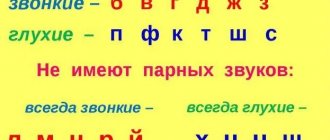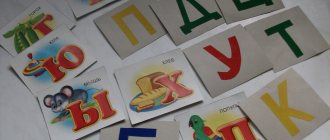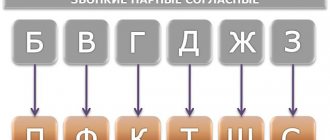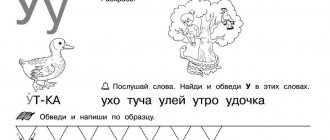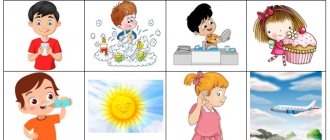Lesson summary in the Russian language Hard and soft consonant sounds, their designation in writing
2. A minute of penmanship.Preparing fingers for writing (finger gymnastics).
— Scientists have proven that every person’s talents are at their fingertips. To make our notebooks beautiful and competent, let’s perform finger exercises:
We chop and chop cabbage. We three, three carrots. We salt the cabbage, salt it. We press and press cabbage.
— We pulled on the “magic gloves” and wrote the first line:
Masha the bear
Compare them. What letter do the words begin with?
What letter will we write during the penmanship minute?
m
State the purpose of your work.
- Write all letters the same height
— Write down the number, great job.
On the desk:
Mm Mmm Mmmm
-Find a pattern. Write down and continue the series.
Underline with a pencil those letters that correspond to the rule of beautiful writing
— Rate your work.(!, +, -)
On the slide:
Bear, Masha
4. Guys, do you like fairy tales? Then let's go to the wonderful, mysterious world of fairy tales, where miracles always happen.
- Guess what fairy tale greets us? Listen:
Girl sitting in a basket
Behind the bear's back.
He himself, without knowing it,
He carries her home. ("Masha and the Bear")
- What is the girl's name? (Masha). Say the first sound ([m]). Describe the sound (Consonant, voiced, hard)
- Who carried Masha home? (Bear). Say the first sound ([m']). Describe the sound. (Consonant, voiced, soft).
- Compare these sounds: - how are they similar? (Consonant, voiced)
- How are they different? ([m] is hard, and [m'] is soft).
- Name the letter to represent these sounds. (M)
- What determines the softness and hardness of a consonant sound? (from vowel)
Formulate the topic of the lesson (Hard and soft consonants)
What is our goal:
!) Distinguish between hard and soft consonants
2) Let’s conduct a study on how hard and soft sounds are indicated in writing
Let's open the textbook on p. 53 and read the topic that the author gives us.
- Work on the topic of the lesson.
- Make pairs of words: (on the board)
Glad-
Small
Onion-
Garden-
What do the words in the first column have in common?
—
And in the words of the second column?
-Which letters indicate the hardness of the preceding consonants?
- What indicates the softness of consonant sounds?
- How else can the softness of the preceding consonant be indicated?
-What do we know about the soft sign?
5. You did the task so well, Masha and the Bear invite you to play the game “Harvest.”
- Look at the objects (vegetables).
— Let’s help the heroes collect objects based on the first sounds. Masha collects objects whose names begin with a hard consonant sound [m] - the girls help her
- The bear collects objects whose names begin with a soft consonant sound [m'] - the boys help him. Show the correct card. (Work standing)
- Be careful,
- Boys, name what items the bear collected (beets, turnips, cucumbers, tomatoes).
- Girls, name what items Masha collected (onion, pumpkin, cabbage, eggplant). pumpkin).
Conclusion:
-What are the types of consonants? (hard and soft, unpaired hard and unpaired soft).
- What unpaired hard consonants do you know? ([zh], [w], [ts]).
-And unpaired soft ones? ([th'], [h'], [sch'])
— How is the softness of consonants indicated in writing? (ь or vowels: e, e, yu, i, and)
If you hear a soft sound, squat; if it is hard, jump.
Feast, cat, nanny, steam, chalk, heat, forest, house, cheese, drank, ardor, sang, floor.
—
Article:
The goal is to learn to distinguish the letters A-Z by ear and in writing.
Tasks:
Correctional and educational:
- Improve knowledge about vowels of the first row and the formation of vowels of the second row;
- Learn to distinguish between hard and soft consonants before vowels A-Z;
- Learn to differentiate the letters A-Z by ear and in writing at the level of syllables, words, phrases and sentences;
- Consolidate knowledge about the mechanism of writing the letters “a” and “z”, their graphic features;
- Replenish and activate the dictionary.
Correctional and developmental:
- develop spatial concepts;
- develop auditory attention, phonemic perception;
- consolidate the skill of synthesizing the letters “a” and “i” from their elements;
- develop phonemic synthesis skills;
- develop VPF;
- develop communication skills.
Corrective education:
- cultivate hard work;
- cultivate a sense of mutual assistance;
- cultivate goodwill;
- develop the skill of self-control;
- develop adequate self-esteem.
Equipment: Anya doll, table of vowel sounds, images of lowercase and uppercase letters A-Z, workbooks, task cards.
Progress of the lesson.
- Organizing time.
— Today a girl with a magical name came to our lesson. Her name is Anya. What do you think, children, what is special about our guest’s name? (the fact that it can be read from left to right and right to left)
- Exactly right!
— What is the first letter of the girl’s name (A), and what is the last letter? (I).
- Fine. Look at the vowel chart. How many rows does it have? (2 rows of vowels) Look, what color are the sounds of the first row? (in red) Which of our sounds is in this row? (A)
— What colors indicate the vowels of the second row? (green and red) Explain why the vowels of the 2nd row are indicated in two colors? (because they can represent 2 sounds)
- That's right, vowels of the second row are formed with the help of [th] and vowels of the first row. But these vowels designate 2 sounds only in those cases if they are at the beginning of a word, if they are after vowels, and if they are after -ь- and –ъ-. Which of the vowels we need is in the second row? (I)
- Children, do you want to know how many sounds the letter I represents in the words Anya and Yana? (Yes)
- Let's put these names in sound outfits then.
-How many sounds does the letter I represent in the word Anya? (one)
— How many sounds does the letter I represent in the word Yana? (two) Why? (because it comes at the beginning of the word.)
- Well done! So, the vowels A-Z are called paired. In order not to confuse them when writing, we will learn to distinguish between them.
- Main part.
- "True False"
Check the box next to the correct statement; if the statement is false, put a dash.
- The vowels o, a, u, y, e indicate the softness of the previous consonant,
- The vowels e, e, i, yu, i indicate the softness of the previous consonant,
- The letter a denotes the vowel sound [a] and indicates the hardness of the previous consonant,
- The letter i denotes the vowel sound [я] and indicates the hardness of the previous consonant,
- The letter i denotes the vowel sound [a] and indicates the softness of the previous consonant
- Visual analysis of the letters “a” and “z”, determining their similarities and differences.
Lowercase and uppercase letters A-Z are displayed on the board.
- Look at the letter “a”. What elements does the letter “a” consist of? (The letter “a” consists of an oval and a hook, which is located to the right of the oval) - the elements of the letter “a” are written on the board).
– What about the letter “I”? (The letter “I” consists of a circle and an element that is located to the right of the circle, and an element that goes down - the elements of the letter “I” are written on the board).
– So, how are the letters “a” and “i” similar? (Both letters have an element - a hook)
– How are these letters different?
– Now let’s write the handwritten lowercase letters “a” and “i” in the air.
(Children write handwritten lowercase letters “a” and “z” in the air).
- Differentiation of letters A-Z at the syllable level.
Listen, memorize and repeat the series of syllables. One row each in a chain.
Ta-ta-ta-ta
Rya - ra - ra - rya
Nya - na - na - nya
Me - ma - me - me - ma
Ba-bya-ba-ba-bya.
- Development of phonemic synthesis.
- Now, guys, let's collect words from letters and read them. What words did you come up with?
d, d, i, i z, m, l, e, i n, n, i, i,
k, r, t, o, a, n d, b, g, o, i, r, a k, r, i, a, o, g
(snag, nanny, tramp, earth, uncle, cardboard)
- Physical education minute.
"Apple"
Reach out your hand and pick an apple.
The wind began to shake the apple tree,
It's hard to pick an apple.
I’ll jump up and extend my hand -
I'll quickly pick an apple.
- Differentiation of letters A-Z at the word level.
Complete the words by adding the letter A or Z.
Mish__, fish__, earth__, grass__, family__, mountains__, sea__, Women__.
-What color do we use to indicate the consonants that precede the letters A-Z? Emphasize them.
- Differentiation of letters A-Z at the level of phrases
“They sent us a magical message, but we can read it only when we insert the missing letters into the words and select the appropriate word from the right column for each of the left columns.”
TINY B...BARREL...
SMART MOUSE…
FURRY SNAKE…
GRAY MONKEY...N...
POISONOUS CAT...
BRIGHT FOX…
- Differentiation of letters A–Z at the sentence level.
Write the sentences in your notebook, inserting the missing letters A-Z.
An__, Kat__ and Ir__ played f____.
- Lesson summary:
– What letters did we learn to distinguish today? (Vowels “a” and “ya”).
– What do they have in common? (Vowels)
– How do the letters “a” and “i” differ? (Consonants before the vowel “a” sound hard, and before the vowel “ya” they sound soft).
– You did a very good job in class. I hope that now you will never confuse the letters “a” and “i” in writing.

